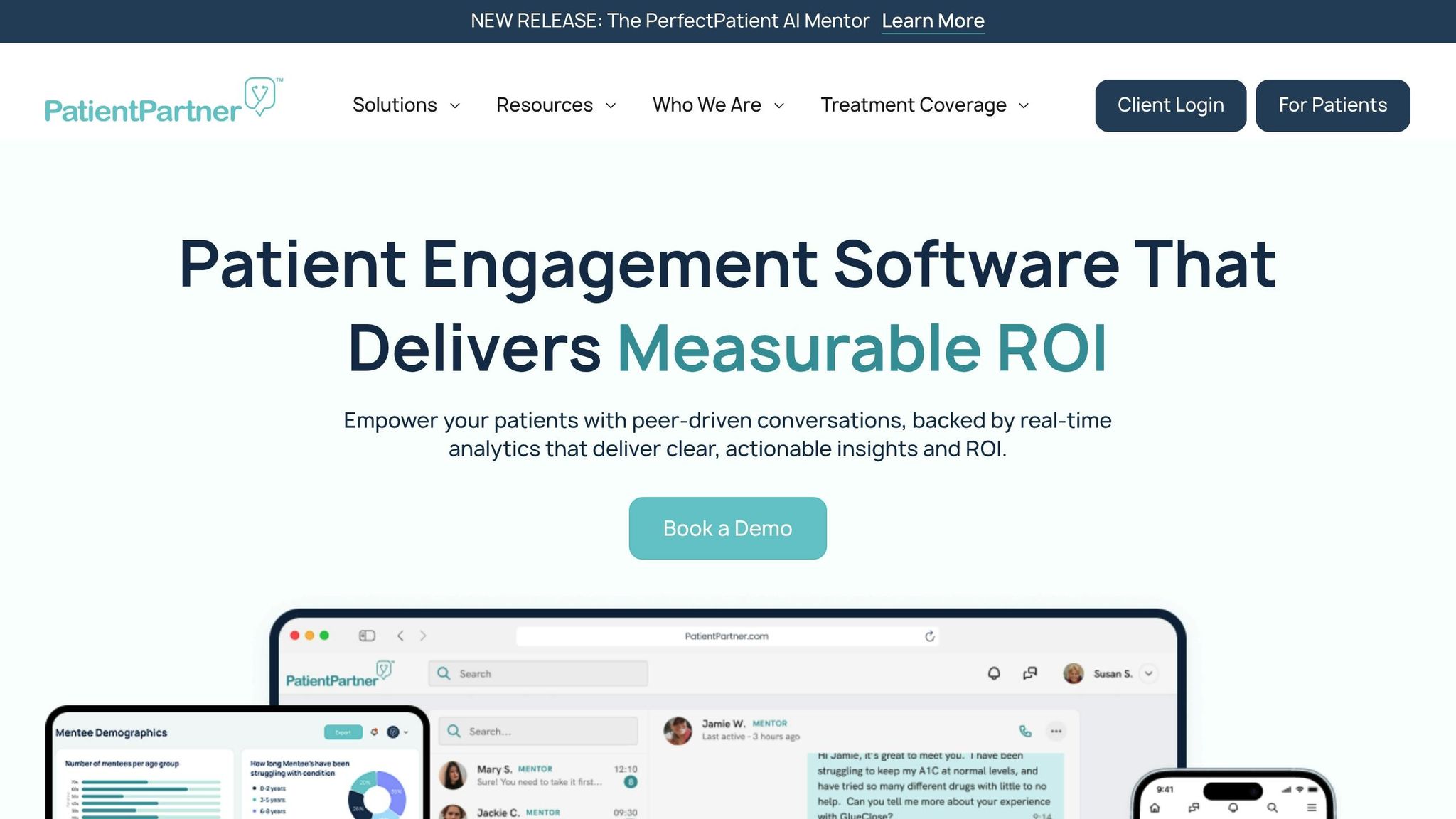Maximizing Treatment Adoption: The ROI of Tailored Patient Journeys


Key Takeaways
Maximizing Treatment Adoption: The ROI of Tailored Patient Journeys
Tailored patient journeys are transforming healthcare by addressing individual needs to improve treatment adoption. Poor medication adherence leads to worse health outcomes and higher costs, but personalized care strategies are helping to solve this problem. Key takeaways include:
- Personalized Support Works: Addressing patient-specific challenges - like financial concerns or side effects - boosts engagement and adherence.
- ROI Metrics Matter: Measuring new patient starts, adherence rates, and cost savings highlights the financial and clinical benefits of tailored care.
- Mentorship Programs Help: Platforms like PatientPartner connect patients with mentors who provide relatable, real-time guidance, improving confidence and adherence.
- Data-Driven Insights: Sentiment analytics and predictive tools help identify struggling patients early, preventing treatment drop-offs.
- Integrated Technology: Combining mentorship with digital tools like telehealth and mobile apps enhances patient engagement and outcomes.
Interview In Action: Better Medication Management and Population Health with Weston Blakeslee
Using PatientPartner for Real-Time Patient Mentorship

Real-time mentorship has the power to reshape a patient's treatment journey by offering immediate support to tackle medical decisions and emotional hurdles. PatientPartner's platform steps in by connecting patients with mentors who have faced similar challenges. Whether it’s a late-night moment of anxiety or a quick chat during a lunch break, this platform ensures patients have someone to turn to when they need it most.
What sets PatientPartner apart is its ability to provide unbiased, relatable support. Mentors share their own experiences, helping patients set realistic expectations and feel more confident about their treatment choices. These one-on-one interactions pave the way for patients to explore the platform’s full range of features.
PatientPartner Platform Features
At the heart of the platform is a personalized mentor-matching system that goes beyond the basics. It takes into account treatment history, lifestyle, and personal preferences to create connections that feel natural and relevant. For instance, a patient juggling a chronic condition and a demanding job might be paired with a mentor who has successfully navigated similar challenges, making the advice more relatable and actionable.
The platform also leverages data-driven sentiment analytics to provide deeper insights into how patients feel throughout their treatment journey. Unlike traditional surveys that only offer occasional snapshots, this system continuously tracks engagement and emotional patterns. This means healthcare organizations can identify when patients are struggling - potentially preventing treatment drop-offs before they happen.
Communication between patients and mentors happens through HIPAA-compliant channels, whether via messaging, video calls, or scheduled check-ins. This flexibility ensures patients can connect in the way that feels most comfortable for them, removing potential barriers to seeking help. These features directly contribute to increasing new patient starts and maintaining long-term adherence.
Boosting New Patient Starts and Long-Term Adherence
Personalized mentorship plays a key role in encouraging patients to start and stick with treatments. When patients can talk to someone who has firsthand experience with a treatment, it eases concerns and builds trust. Mentors can address practical questions - like managing side effects or navigating insurance coverage - that clinical information alone might not fully address.
Pharmaceutical companies benefit too, as patients are more likely to begin treatment when their concerns are addressed by someone who’s been there. Long-term adherence improves when patients have ongoing support, not just at the start. Mentors help patients incorporate treatments into their daily lives, offering tips for managing side effects, keeping up with doses, and staying motivated through difficult times. This sustained guidance helps patients stay on track, reducing the likelihood of stopping treatment prematurely.
Healthcare providers also see advantages, as mentors handle routine concerns, freeing up clinical staff to focus on more complex medical decisions. This approach keeps patients engaged while easing the workload for healthcare teams.
HIPAA Compliance and Data Security
PatientPartner’s platform is built with compliance and security at its core, adhering to HIPAA, GDPR, and FDA guidelines. This ensures healthcare organizations can confidently implement the platform without risking regulatory issues or patient trust. Every interaction, from mentor matching to ongoing conversations, is protected by advanced encryption and secure data handling protocols.
The platform also uses automated systems to monitor interactions, ensuring strict HIPAA compliance and safeguarding patient privacy. This continuous oversight allows mentors and patients to communicate naturally without worrying about security or regulatory concerns.
Additionally, the "PerfectPatient" AI Mentor is tailored to align with specific treatment protocols, legal guidelines, and medication information, ensuring all guidance remains within FDA-approved parameters. This balance of compliance and personalization provides patients with the support they need while maintaining the highest standards of safety and accuracy.
For healthcare organizations, this compliance-ready framework eliminates the lengthy approval processes often required for patient engagement tools. With these safeguards in place, organizations can focus on improving patient care and outcomes without being bogged down by regulatory hurdles.
Practical Strategies for Better Patient Engagement and Adherence
Improving patient engagement doesn't have to feel like an uphill battle. By addressing concerns early and weaving supportive strategies into existing workflows, healthcare providers can create a smoother, more proactive patient experience. These approaches ensure patients stay on track with their treatment while fostering trust and understanding.
Adding Mentorship SaaS to Patient Journeys
Incorporating mentorship platforms into patients' care routines can make a world of difference, especially during moments when they feel uncertain or overwhelmed. Think about those pivotal times - like right after a diagnosis, when starting a new treatment, or when side effects emerge. These are the moments when patients need guidance the most, and mentorship services can step in seamlessly.
Set up referral systems that automatically connect patients to mentors during these critical points. For example, when a prescription is initiated, mentorship support can be triggered to complement the educational materials patients receive. This ensures they get immediate peer support when it matters most.
Rather than taking over the role of healthcare providers, mentorship platforms act as a helpful extension. They handle routine questions and provide emotional support, allowing medical professionals to focus on clinical decisions. Equip your clinical staff with the tools and confidence to introduce these mentorship services effectively. When providers explain how these platforms work and highlight their benefits, patients are far more likely to embrace them. This not only boosts adherence but also enhances the overall return on investment (ROI) for healthcare organizations.
Using Data-Driven Patient Sentiment Analytics
Mentorship is just the start. To keep patients engaged throughout their journey, healthcare providers can rely on data-driven sentiment analytics. Unlike traditional metrics like prescription refills or missed appointments, sentiment analytics dig deeper, revealing how patients truly feel during their treatment.
The most actionable insights come from continuous interactions rather than one-off surveys. By monitoring real-time communication patterns, engagement levels, and response times, providers get an instant snapshot of the patient experience. If the data shows declining engagement or negative trends, teams can step in before the situation worsens.
Predictive analytics take this a step further by flagging patients who might be at risk of stopping treatment. These systems analyze patterns in communication and sentiment to identify those who may need extra support. Acting on these insights early can prevent treatment drop-offs and keep patients on track.
To make the most of sentiment data, healthcare organizations should have clear protocols in place. For instance, if analytics suggest a patient is struggling, the response should be quick and tailored to their needs. This might include connecting them with a mentor who has faced similar challenges, adjusting how often they’re contacted, or offering additional resources that address their specific concerns. Personalized interventions like these not only enhance engagement but also improve long-term outcomes and ROI.
Creating Tailored Engagement Programs
Beyond automated systems and analytics, personalized engagement programs can adapt to each patient’s unique needs. These programs start with understanding how patients prefer to communicate and receive support, ensuring a more individualized approach that consistently outperforms generic methods.
Demographics play a big role in shaping these programs. For instance, younger patients often favor text messages and mobile-friendly options, while older patients may feel more comfortable with phone calls or video chats. Similarly, working professionals might need evening or weekend support, whereas retirees may prefer daytime check-ins. By accommodating these preferences, participation rates can soar.
Flexibility is key. Offering a mix of on-demand support and scheduled check-ins ensures patients can access help when they need it most. Additionally, acknowledging cultural differences is crucial. Patients from diverse backgrounds may have varying levels of comfort with peer support, different communication preferences, or concerns about privacy. Programs that respect these factors and provide culturally sensitive options are far more effective.
Finally, the best engagement programs evolve alongside the patient journey. Support needs change over time, whether patients are starting treatment or transitioning to long-term management. Programs should automatically adjust the frequency and focus of communication to align with where patients are in their care timeline. This adaptability keeps patients engaged, improves adherence, and sustains ROI throughout the entire journey.
sbb-itb-8f61039
Measuring ROI: Methods and Case Studies
Building on earlier discussions about personalized patient care, analyzing ROI combines hard numbers with real-life patient success stories. To evaluate ROI for customized patient journeys, it's essential to track both immediate financial effects and the long-term value generated throughout the patient lifecycle.
Methods for Calculating ROI
Before rolling out personalized patient journey programs, it's crucial to set clear baseline metrics. Here are some key performance indicators to focus on:
- Cost per patient acquisition: Includes expenses for marketing, outreach, and initial engagement efforts.
- Patient lifetime value (PLV): Reflects the total revenue generated over the course of a patient’s treatment journey.
- Adherence improvement rates: Tracks sustained patient engagement and compliance with treatment plans.
- Cost avoidance: Measures savings from reduced dropouts and better use of resources.
- Time-to-treatment metrics: Evaluates how quickly patients progress from initial contact to active treatment.
- Real-time sentiment analytics: Provides early insights into patient engagement and satisfaction, enabling proactive support.
These metrics offer a comprehensive view of both short-term results and long-term gains, helping to paint a clear picture of the impact personalized patient journeys can have.
Case Studies: Tailored Journeys in Practice
Several case studies highlight the benefits of these ROI methods in action. For instance, organizations using the PatientPartner platform have demonstrated notable successes. Real-time patient mentorship programs have led to higher medication adherence, improved patient satisfaction, and fewer dropouts. Providers have also seen more efficient patient acquisition processes and an uptick in referrals, all contributing to a stronger ROI.
Additionally, tailored patient journeys using PatientPartner have shown to streamline treatment initiation, ease care transitions, and deliver better outcomes. These examples underscore how personalized patient support strategies not only boost financial performance but also enhance clinical results, creating a consistent narrative of value through meaningful patient engagement.
Technologies That Drive Treatment Adoption Success
Achieving success in treatment adoption means combining patient mentorship with cutting-edge digital health technologies. This blend creates smoother patient engagement and better outcomes, as explored in the sections below.
Digital Health Tools and Real-Time Support Systems
Real-time support systems have transformed patient care by improving communication and delivering measurable results. These platforms connect patients, caregivers, and providers, ensuring that responses to treatment needs are both timely and effective.
The benefits go beyond simple communication. Care coordination platforms have been shown to deliver an impressive ROI of 7–10x while saving time for healthcare teams. Automation within these systems allows clinicians and staff to focus on patient care instead of administrative tasks.
Take IPR Healthcare, a home health and hospice agency serving over 400 patients, as an example. By adopting the Care Coordinations platform, they enhanced patient support through real-time care collaboration. This system streamlined workflows and made it easier to implement personalized care plans tailored to each patient's unique needs.
"We recommend this real-time care collaboration platform." - Zedrick Buhay, COO
The results speak for themselves. Healthcare organizations using integrated care coordination systems have reduced hospital and ER visits by 30–40%, especially for higher-acuity patients. These platforms enable proactive, real-time interventions that significantly improve patient outcomes.
Meanwhile, mobile health apps - now totaling over 350,000 - offer tools like personalized health data, medication reminders, and condition-specific education. These apps empower patients to stay engaged with their treatment plans.
AI-powered chatbots add another layer of support by answering medication-related questions, managing side effects, and scheduling appointments. This ensures patients have consistent access to guidance throughout their treatment journey.
Telehealth platforms also play a critical role by enabling follow-up consultations and ongoing care. They help patients understand medication instructions, stay informed about side effects, and maintain treatment adherence through continuous interaction with healthcare providers.
Integration Best Practices for U.S. Healthcare Providers
The key to maximizing the potential of these digital tools lies in effective integration. Rather than deploying isolated technologies, healthcare providers should aim for a unified, personalized system that meets individual patient needs.
PatientPartner illustrates how integration can work seamlessly. By combining patient mentorship with data-driven sentiment analytics, it helps providers deliver both meaningful human connections and actionable insights to refine engagement strategies.
For successful implementation, healthcare providers should prioritize automation and artificial intelligence within care coordination software-as-a-service (SaaS) platforms. These tools simplify the creation of personalized care plans and enable real-time collaboration, reducing the workload for clinical staff.
Maintaining HIPAA-compliant security across all patient interactions is essential for building trust and fostering deeper engagement.
Scalable SaaS platforms also offer the flexibility to adapt to evolving patient demographics and treatment protocols while maintaining high-quality care and support.
The landscape of patient engagement has shifted from passive communication to an active, two-way process. Patients are now empowered to take an active role in managing their health, making it essential for technology platforms to support real-time feedback and ongoing dialogue.
Additionally, combining digital tools with patient ambassador programs can create impactful peer-to-peer connections. These programs blend the empathy of human interaction with the efficiency of digital solutions, further enhancing treatment adoption.
Conclusion: Maximizing ROI Through Tailored Patient Journeys
Creating personalized patient journeys offers a clear path to stronger ROI for healthcare providers and pharmaceutical companies. By stepping away from a one-size-fits-all approach and focusing on tailored engagement strategies, organizations can achieve measurable results while improving patient care.
Successful healthcare organizations understand that encouraging treatment adoption isn’t just about offering options - it’s about building comprehensive support systems that address each patient’s specific needs.
One standout example is real-time mentorship, which connects patients with experienced guides. This human-centered approach improves both new patient starts and long-term adherence, all backed by data-driven insights.
PatientPartner exemplifies this strategy with its integrated platform. Its features - such as real-time mentorship, personalized mentor matching, and sentiment analytics - help foster meaningful connections while continuously refining how patients are engaged.
When digital health tools, telehealth platforms, and care coordination systems are brought together in a unified, patient-focused ecosystem, the result is a smoother, more seamless experience for patients. This kind of integration not only enhances adherence and clinical outcomes but also boosts financial performance through improved cost efficiency and patient retention.
To succeed in value-based care, healthcare providers must prioritize clear metrics, robust data collection, and the ability to adapt quickly based on patient feedback. As the industry continues to evolve, recognizing patients as active participants in their care journeys will be key.
PatientPartner is at the forefront of this shift, empowering providers to deliver tailored support that improves patient outcomes while driving organizational growth. By focusing on personalized care, healthcare organizations can achieve better results for both patients and their bottom line.
FAQs
How does personalized mentorship with PatientPartner help patients stick to their treatment plans?
Personalized mentorship through PatientPartner offers patients a unique blend of emotional support and practical advice, tailored specifically to their needs. This approach helps patients feel genuinely understood and supported, which, in turn, encourages them to stick to their treatment plans. The result? Better adherence and a stronger commitment to their care.
On top of that, tools like real-time monitoring and digital health support play a key role in tackling challenges as they come up. These tools keep patients engaged and ensure they stay on track. Together, these personalized approaches not only improve adherence but also pave the way for healthier outcomes overall.
How can data-driven sentiment analytics help reduce treatment drop-offs, and what’s the best way to integrate them into patient care?
Data-driven sentiment analytics play a key role in minimizing treatment drop-offs by spotting early indicators of patient disengagement. By examining emotional tone and feedback, healthcare providers can predict potential concerns and step in early to help patients stay committed to their treatment plans.
To put sentiment analytics to good use, tools like natural language processing (NLP) can analyze patient feedback to uncover emotional states or underlying worries. This approach allows for personalized communication and customized support, improving patient engagement, satisfaction, and adherence - contributing to more positive health outcomes overall.
How can healthcare providers evaluate the ROI of using digital tools and mentorship programs to create personalized patient journeys?
Healthcare providers can measure ROI by focusing on specific metrics like better medication adherence, lower readmission rates, and improved operational processes - think more efficient appointment scheduling or smarter resource management. On top of that, financial markers such as cost savings and increased revenue offer clear, quantifiable insights.
Another angle to consider is tracking patient engagement and noting decreases in hospital stays or emergency visits. These results highlight how personalized care pathways, bolstered by mentorship programs and digital tools, can deliver not only improved patient outcomes but also meaningful financial benefits.
Author

Co-Founder and CEO of PatientPartner, a health technology platform that is creating a new type of patient experience for those going through surgery
Related Articles
Stay Ahead in Patient Engagement
We and selected third parties use cookies or similar technologies for technical purposes and, with your consent, for other purposes as specified in the cookie policy. Use the “Accept” button or close this notice to consent.
We and selected third parties use cookies or similar technologies for technical purposes and, with your consent, for other purposes as specified in the cookie policy. Use the “Accept” button or close this notice to consent.






